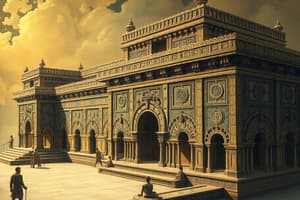Podcast
Questions and Answers
¿Cuál fue la característica principal de la arquitectura de Tiwanaku?
¿Cuál fue la característica principal de la arquitectura de Tiwanaku?
- El empleo de técnicas de construcción avanzadas, como el hormigón
- La utilización de bloques de piedra, algunos de más de 100 toneladas (correct)
- La presencia de decoraciones intrincadas y esculturas
- El uso de materiales ligeros, como la madera y el bambú
¿Dónde se encuentra la ciudad de Tiwanaku?
¿Dónde se encuentra la ciudad de Tiwanaku?
- En el norte de Bolivia, cerca de la frontera con Perú
- En el centro de Bolivia, cerca de la ciudad de La Paz
- En el este de Bolivia, cerca de la frontera con Brasil
- En el oeste de Bolivia, cerca de la orilla sur del Lago Titicaca (correct)
¿Cuál era la principal actividad económica de la sociedad de Tiwanaku?
¿Cuál era la principal actividad económica de la sociedad de Tiwanaku?
- El comercio y la explotación de los recursos naturales de la región
- La agricultura, particularmente en la producción de maíz y papas (correct)
- La minería y la explotación de minerales
- La pesca y la explotación de los recursos marinos
¿Por qué la ciudad de Tiwanaku comenzó a declinar alrededor de 1000 AD?
¿Por qué la ciudad de Tiwanaku comenzó a declinar alrededor de 1000 AD?
¿Qué es Tiwanaku hoy en día?
¿Qué es Tiwanaku hoy en día?
Flashcards are hidden until you start studying
Study Notes
Location and History
- Located in western Bolivia, near the southern shore of Lake Titicaca
- Founded around 300 AD, flourished until 1000 AD
- Capital city of the Tiwanaku state, which was a major power in the region
Architecture and Engineering
- Known for its impressive stone architecture, including:
- The Gate of the Sun, a monolithic stone gateway
- The Akapana, a stepped pyramid
- The Kalasasaya, a temple complex
- Tiwanaku's architecture is characterized by:
- Use of stone blocks, some weighing over 100 tons
- Precise stonework, with no mortar used
- Advanced irrigation systems and drainage channels
Culture and Society
- Tiwanaku was a theocratic society, with a strong priestly class
- The city was likely a center of religious and ceremonial activity
- Tiwanaku's people were skilled in:
- Agriculture, particularly in the production of maize and potatoes
- Metallurgy, including the use of copper and bronze
- Weaving and textiles
Decline and Legacy
- Tiwanaku began to decline around 1000 AD, likely due to:
- Environmental degradation and drought
- Invasions by neighboring groups
- The city was abandoned, and its legacy was largely forgotten until the 20th century
- Today, Tiwanaku is a UNESCO World Heritage site and a major tourist destination
Studying That Suits You
Use AI to generate personalized quizzes and flashcards to suit your learning preferences.

